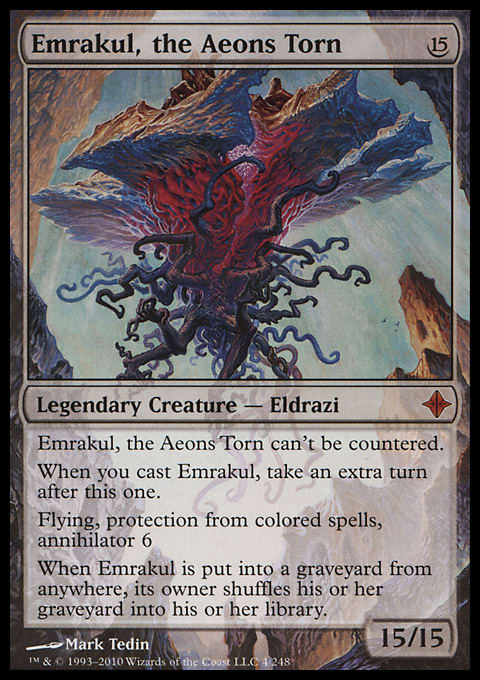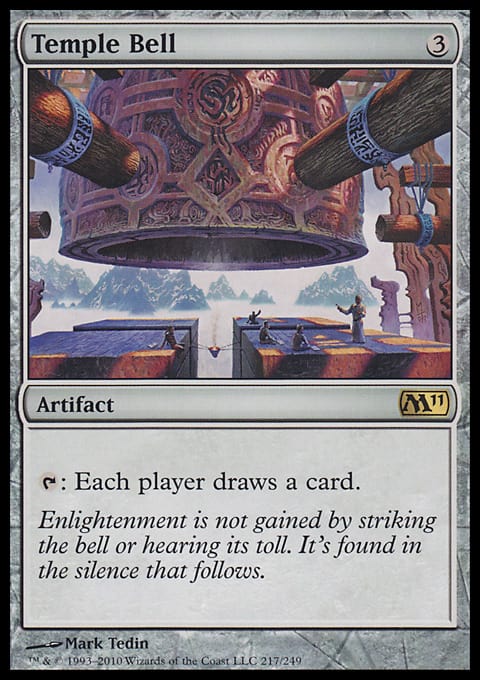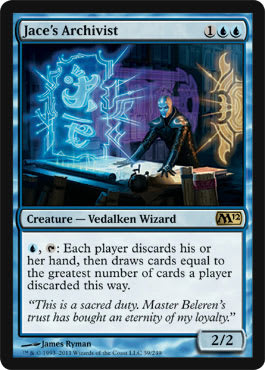Not many topics annoy me as much as card advantage. Many players with reasonable knowledge of Magic theory read about card advantage and port the theory directly into multiplayer Magic, assuming that a theory as sound as card advantage will work the same way in multiplayer games as it does in one-on-one. It simply is not true.
The History
If card advantage theory is completely new terminology for you, I recommend you go here. Ted Knutson explains it far more thoroughly than I can. The basic idea of card advantage theory is that if you can use one card to deal with two cards from your opponent, you have an advantage. You will have more threats available to you later in the game, which should produce more wins. Ted goes much deeper, explaining virtual card advantage and various ways to generate card advantage.
We have seen a variety of Jund decks that exemplify the card advantage theory. The deck would provide the player with two cards to the opponent’s one or eliminate an opponent’s threat with a single card (a one-for-one). This would eventually grind the opponent down and give the Jund player an incremental advantage that would lead to wins—card advantage theory in action.
I have talked about card advantage in multiplayer before, most recently at the Muse Vessel, but also years ago at StarCityGames. The Muse Vessel article is probably the only one you need to read if you are looking to get up to speed when considering card advantage theory in multiplayer. The basic variations of card advantage in multiplayer is that with multiple opponents, both of the following are true: Trading one for one with an opponent is a losing battle since there are multiple opponents and you can’t realistically outdraw all of your opponents;1 and, Often, you won’t need to spend a single card to deal with a threat because someone else will do it for you. If other players are using up cards to play threats and stop threats, while you sit and do nothing, you are accruing card advantage.
Applying Card Advantage Theory: Come Get Some and Camouflage Styles
There are generally two styles of play in multiplayer games. The first style is the “Come Get Some” style. The idea is that you will load your deck with powerful cards and excellent synergy and dare your opponents to stop you. The attitude is very much you-against-the-world.
This attitude can make card advantage extremely difficult to attain. Let’s say you are playing a game against Daryl, Brandon, and Bruce. You are all about playing the big haymaker and daring your opponent to stop you. While Bruce is a little thick-witted, Daryl and Brandon are bright guys. They watch you play one huge spell after another and make you out to be The Threat, at least early on. They bring Bruce onboard, and all three of them start to work taking you down. You have a great deck, and it seems that it is taking them two cards just to stop one of your cards. While you do eventually manage to take out Bruce, Brandon and Daryl keep the pressure on and take you out of the game.
When looking back at the example, we see you had card advantage at individual points in the game, but overall, you lost out. Your opponents were outdrawing you three-to-one, so even if they were forced to use more cards to eliminate your threats, they were still pulling away in card advantage. That eventually caught up to you.
The second style of play is what I call “Camouflage.” You lay in the weeds, trying not to appear to be the threat, then jump out toward the end of the game and snatch the victory.
This style of play makes card advantage easier to obtain. This time, you are playing the Camouflage style. When you play a spell, Brandon might try to stop you because he is the biggest threat at the table, but Daryl and Bruce aren’t trying to stop you because they expect that your resources will be used to stop Brandon. When determining card advantage here, you are in a one-to-one battle with Brandon, but since he is in that same battle with everyone else, he is unlikely to be able to maintain it, and you will have card advantage.
Threat Level Multiplier
All of this is great in theory, but practically speaking, when you are carefully and rationally playing a multiplayer game, you aren’t considering card advantage theory—you are doing a constant threat assessment. Is the threat serious? Do others recognize the threat? Are you the only one actually threatened, or is this a problem for everyone? Do you need to deal with the threat now or later? Is it something that someone else will deal with before you have to? Card advantage theory is part of your assessment, but when push comes to shove, you’ll toss card advantage theory in the trash and get three-to-one’d if need be.
I was having a discussion with my friend George after a night of Magic, and we were talking about this idea. Our discussion initially focused on Josh, who had won the last game of the evening. Josh is one of the better players in our group. Both of us agreed that it was important to always be aware of what Josh was doing, making sure to never let his decks get rolling. George talked about card advantage and explained that he would be willing to give up card advantage to a weaker player, but not to Josh, since Josh was almost always a greater threat.
George’s thought was that card advantage theory is fine in the abstract, but practically speaking, there are variables that affect how you view card advantage in a practical manner. These variables create a multiplier for the basic card advantage theory. Let’s go back to our example from earlier.
You are playing a game against Daryl, Brandon, and Bruce. We already mentioned Bruce is dim-witted, and in this example, Brandon is playing his barnyard theme deck. Every card is somehow related to farm life. It is a pretty funny deck, but it lacks the punch of some of his more competitive decks.
You are considering playing Temple Bell.2 How good or bad is this play? Threat Level Multiplier Theory weighs the strength of each player’s card-draw. Daryl is the best player, and you know his deck is one of his better ones. Considering these advantages, you would rate his card-draw at 1.5 to your 1. Brandon is a good player, probably as good as you, but his theme deck is mostly goofy jank cards that don’t offer a real threat. His card draws are probably only .75 to your 1. Bruce is running a good deck, but he pilots it poorly and tends to make the wrong play. His card draws are .5 to your 1.
Using card advantage theory, your Come Get Some play style will make this a play where your opponents are drawing three cards and you are only drawing one. Threat Level Multiplier Theory finds you at a card disadvantage, with the ratio at (1.5 + .75 + .5) 2.5 to 1. Not as bad as the three-to-one that regular card advantage theory would suggest, but it’s still not great.
If you are playing a Camouflage style and can determine that Daryl is the obvious primary threat to everyone on the board, arguably, your team is drawing three cards, while Daryl draws only one. If Daryl is the primary threat, your advantage is only 2.5 (1 + .75 +.5) to Daryl’s 1.5. While playing the Temple Bell is still a better option than not, you might think twice if you think Brandon might decide to sit on the sidelines and not work to help take down Daryl. Suddenly, the advantage becomes much smaller, and you had to play a card to generate that advantage.
Threat Level Multiplier Theory uses your knowledge of the metagame to give you a more accurate assessment of the true card advantage. Not only do you look at the skill of the players involved and the decks they are using, but you also look at the game’s dynamic. Daryl may be the strongest player, but if Brandon is one card away from winning, Daryl’s Threat Level Multiplier goes way down, and Brandon’s goes way up.
Threat Level Multiplier Theory is only as good as your information. If you are with a new group, your knowledge of who the best players and best decks are is limited. You don’t know how this group of players will respond to threats, so there is really no way to apply the multiplier. Even when you know the group, if you don’t know the decks, your information is incomplete. While you may form a better sense of your true card advantage—or disadvantage—you don’t have perfect information, so the multipliers you apply aren’t necessarily accurate.
Even with perfect information, you are placing an arbitrary number as to the value of card advantage. The value of the Threat Level Multiplier Theory is in awareness. Assuming a three-to-one card disadvantage when everyone draws a card is only the roughest of estimates. Knowledge of your metagame can make you more aware of the true card advantage seen in your games.
Bruce Richard
1 Yes, I know, Consecrated Sphinx. We are talking in broad strokes here, people. I’m introducing a theory, not focusing on the exceptions. Go with me on this one for a bit.
2For the older players, feel free to insert Howling Mine here. Although really, for 1 extra mana, you get to decide when everyone draws a card. No more of that whole everybody-else-drew-a-card-then-Jerkface-Krosan-Gripped-my-Mine garbage. Dump your Mines. Temple Bells are where it’s at.






























